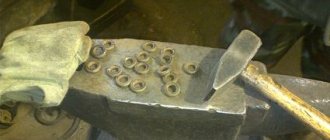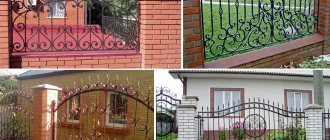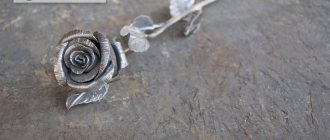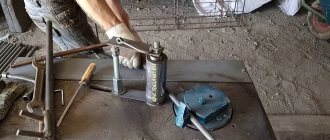Good time. I read a lot about how to weld a package of several strips of metal (special thanks to Nozhedel, he has a lot of photos and the clarity makes a lot of things clear), so everywhere flux or borax is involved in the process, I tried to read about flux on the Internet and almost lost my mind, what did I do? The search didn’t give me any results, but no one has heard of borax in our area, and I don’t know where to get such an animal. True, I recently found something in one fashion store (a jar is approximately the size of Chinese star balm, about 25 grams, costing 115 rubles). If this was the drill that they write about here, then I probably won’t be able to cope financially (I’ve overcome the crisis). In this regard, the actual question is: is there any alternative way to weld a bag without borax.
Well, how to cook carbon without borax, with sand, in my opinion, LBA wrote in Anton’s thread, about a blacksmith who cannot forge without forging.
What's the problem with borax? Medtekhnika stores have it; dental technicians use it for soldering with a torch with carbide solders. I won’t say anything about the price, I don’t remember, but when I looked at the costs, about a year ago, it didn’t seem ruinous.
Borax
from medicine:
INCI classification name: Borax Other names: Sodium borate, Borax, Sodium tetraboric Characteristics: Colorless transparent, easily weathered crystals or white crystalline powder. Soluble in water (1:25 in cold and 2:1 in boiling), glycerin, insoluble in alcohol. Aqueous solutions have a salty-alkaline taste and an alkaline reaction. Density: 1.73
Properties: Emulsifier, preservative, cleansing agent. Antiseptic (disinfectant) agent. Often used as a component of bath salts, borax softens water.
Areas of application: Borax is a natural mineral widely used in the cosmetics industry. Used in creams, lotions, shampoos, gels, salts and bath bombs. In combination with citric acid in bath bombs, it gives a bubbling effect; when mixed with water and guar gum, it can be used as a shower gel.
Medicinal use. Used externally as an antiseptic in adults for rinsing, lubricating the skin (for diaper rash, bedsores), douching (rinsing the vagina with a stream of liquid). Method of administration and dose. 1 tablespoon per 1 glass of water for rinsing. For douching, 4-5 tablets per 1 liter of water.
Concentration and methods of use: In cosmetics - no more than 5% Dilute in hot (75.C) water and then add to cream.
For medicinal purposes, it is used in the form of a 3-5% solution for washing and lubricating the oral cavity, nose and nasopharynx for various infectious diseases (tracheitis, runny nose, stomatitis, etc.).
Precautions and contraindications: Avoid contact with eyes, do not apply orally or directly to the skin (may cause irritation). Keep out of the reach of children and pets
Storage: 2-3 years. Store in a dry place.
Borax
From chemistry and other information:
Borax (sodium tetraborate) Na2B4O7. H2O is a salt of tetraboric acid. Ordinary borax (hydrate decahydrate) forms large, colorless, transparent prismatic crystals; base-centered monoclinic lattice, a = 12.19 Å, b = 10.74 Å, c = 11.89 Å, ß = 106O35´; density 1.69-1.72 g/cm3; In dry air, the crystals erode from the surface and become cloudy. When heated to 80°C, decahydrate (from the Greek deka ten - in compound words means ten, tenfold) loses 8 molecules of water; at 100 degrees, slowly, and at 200°C, another water molecule is quickly split off; in the range of 350–400°C, complete dehydration occurs.
Solubility of borax (in anhydrous salt per 100 g of water): 1.6 (10OC), 3.9 (30OC), 10.5 (50OC). The saturated solution boils at 105°C.
Borax hydrolyzes in water, so its solution has an alkaline reaction. It dissolves in alcohol and glycerin. Completely decomposes with strong acids:
Na2B4O7 + H2SO4 + 5H2O = Na2SO4 + 4H3BO3.
With the oxides of some metals, borax produces colored borates (“borax pearls”):
Na2B4O7 + CoO = 2NaBO2 + Co(BO2)2,
which is used in analytical chemistry to discover these metals.
When a solution of ordinary borax is slowly cooled at 79°C, octahedral borax Na2B4O7 begins to crystallize. 5H2O (or “jewelry borax”), density 1.815 g/cm3, stable in the range 60 - 150°C. The solubility of this borax is 22 g in 100 g of water at 65°C, 31.4 at 80°C and 52.3 at 100°C.
Borax is the most important flux that facilitates the smelting process. When cooled, molten borax forms a glaze on the walls of the crucible, protects the melt from oxygen and dissolves metal oxides.
With the slow thermal dehydration of ordinary borax, a pyroborax with a density of 2.371 g/cm3 and a melting point of 741°C is obtained. Borax melts and breaks down into sodium metaborate and boron trioxide, which mix in a liquid state:
Na2B4O7 → 2NaBO2 + B2O3.
Boron oxide, combining with metal oxides, forms metaborates in the same way as boric acid. Sodium metaborate easily mixes with newly formed metaborates and quickly removes them from the molten metal zone, and new active boron oxide molecules take their place. Borax has a greater ability to dissolve oxides than boric acid, and is used not only as a melting reducing flux, but also as the most important flux for brazing.
Ordinary borax is obtained from boric acid, from tincal, kernite and some other minerals (by recrystallization), as well as from salt lake water (by fractionated crystallization).
Borax is widely used in the preparation of enamels, glazes, in the production of optical and colored glasses, in welding, cutting and soldering of metals, in metallurgy, electroplating, dyeing, paper, pharmaceutical, leather industries, as a disinfectant and preservative and fertilizer
Borax
for Dummies":
Sodium tetraborate (“borax”) -Na2B4O7, a salt of a weak acid and a strong base, a common boron compound, has several crystalline hydrates, and is widely used in technology.
The term “Borax” is used in relation to several similar substances: it can exist in an anhydrous form, in nature it is more often found in the form of pentahydrate or decahydrate crystalline hydrate:
Anhydrous borax (Na2B4O7) Pentahydrate (Na2B4O7.5H2O) Decahydrate (Na2B4O7.10H2O) However, the word borax most often refers to the compound Na2B4O7.10H2O.
What and why is metal sprinkled during forging?
Since at a temperature above the start of forging, intense scale formation occurs and the metal can be burned, then to reduce scale, facilitate its removal and protect the metal from burning, the workpiece is sprinkled with flux. Flux is sprinkled onto the workpiece during the period of heating it to a temperature of 950 ... 1050 ° C.
Interesting materials:
How are we walking in May? How are we walking in May 2022? How is the country celebrating New Year 2022? How does ibuprofen affect blood pressure? How does ginger affect the kidneys? How does inflation affect the exchange rate? How is the length of sick leave calculated? How to search for a picture by picture? How to search for songs in Shazam? How to search a site by image?
Drill for forging metal and flux for forge welding, what can be replaced and how to make it
Borax in working with metals is primarily associated with flux mixtures, which are indispensable for soldering or forging. Borax is sold in the market in powder form. Its value and irreplaceability are determined by its melting point, which reaches 800 – 900°C.
When heated, it turns into a glassy solidified mixture, which provides excellent protection for the work area. In addition to this, borax powder is highly soluble in water. All technical characteristics are described in a separate standard GOST 8429-77 called “Technical Borax”.
About tetraborate and decahydrate
Borax has a serious scientific name because it is nothing more than a combination of a weak acid and a strong base. The name is difficult to remember the first time: sodium tetraborate decahydrate.
Flux for forge welding is a special technological merit of borax, which needs to be discussed separately.
Forging or forge welding with borax
Use of borax according to standards.
The forging process is characterized by strong heating of the workpieces - these are important technological nuances. As a result of such heating, a significant layer of scale is formed on the surfaces of the metal parts being welded until they burn out.
This is where borax comes into play as a savior: metal surfaces are covered with a layer of a mixture of sand and borax - an excellent flux is obtained.
To understand and appreciate the method using borax flux, you need to understand the process itself. Forge welding is a mixed physical method of influencing metals to join them.
Its essence is mechanical action in the form of blows from a forge hammer combined with heating to increase the ductility of the metal.
Forge welding is used for welding steel alloys with the lowest possible carbon content - at the level of 0.3%. High-carbon steels are not suitable for forging; their weldability is too low for this purpose using this method.
A mandatory requirement before the process is to thoroughly remove any contaminants and oxide films from the surfaces of the workpieces.
It should be noted that forge welding, in principle, does not produce strong metal joints; it is far from the most reliable method of forging. In addition, when using it, you cannot do without the professionalism of a blacksmith - without this nothing will work.
Therefore, it is practically not used for industrial purposes and in factories. But when it comes to repair work in the field and in unfavorable conditions, this method is used quite often.
Warm it up thoroughly
The parts are heated in furnaces or furnaces. The amount of fuel must be precisely calculated - no more and no less. The best fuel for forging is charcoal and coke. But in practice, ordinary coal is more often used.
Metal parts are loaded into the forge only after the coal has completely burned out, so that sulfur is removed from it, the presence of which has a bad effect on the quality of the compound.
The heating temperature of the parts must be higher than the level at which forging begins. The level of heating temperature in figures depends on the percentage of carbon in the steel: the lower its content in the alloy, the higher the heating temperature must be raised to melt.
For low-carbon steel, heating should be no lower than 1350 - 1370°C, the distinguishing feature is the shining white color of the metal. If the steel contains a high proportion of carbon, heating to about 1150°C is sufficient, the color will then have a yellow tint.
Forge welding flux is added for protection. It's all about the abundant formation of scale due to heating. Flux mixtures protect against this. Flux for forge welding is poured at a precisely designated moment - when the heating level is between 950°C and 1050°C.
The basis of the mixture is fine clean river sand with the addition of 10% borax after good calcination. Borax in sand promotes good slag formation and easy cleaning of metal from impurities in the future.
The thickness of the layer matters: if it is too thick, heating the parts will reduce speed and quality. Therefore, flux for forge welding is poured in an even and thin layer. The addition of borax to the flux mixture is especially important and necessary if low-quality coal is used.
The flux mixture forms slag, which can drain from the metal workpiece, which is very undesirable. To prevent this, add additional portions of sand to the workpieces - carefully and in moderate quantities.
Iron filings of a soft consistency or ferromanganese are an excellent partner for borax. Sawdust is capable of absorbing carbon from the metal surface under high temperature conditions, thereby significantly improving the quality of the welding process.
If you need to weld parts from different metals or steel grades, then first of all, the metal with a lower proportion of carbon is heated due to its higher melting point. And only then do they begin to work with the second part, the metal of which contains a higher percentage of carbon.
Safety and storage rules for borax
The forging drill does not pose any particular danger from the point of view of explosions or fires. Moderate toxicity is observed due to the boric acid content. Borax can enter the body through the respiratory tract in the form of dust or aerosol spray, as a result of which the mucous membranes can be irritated.
Borax should be stored indoors and always in packages - no spills. Typically, storage is carried out in special containers that should stand on a hard surface. The shelf life of borax is only six months, which must be taken into account when planning purchases and use.
tutsvarka.ru
The use of flux in forge welding
Heating steel causes it to oxidize and become covered with scale, which interferes with welding. Therefore, the ends to be welded are usually sprinkled with flux. In rural forges, quartz sand mixed with borax and table salt is used as a flux. At high temperatures, flux combines with scale and forms a layer of slag, which protects the welding surface from oxidation. When the carbon content in steel is low, fluxes are often not used, since the melting point of such steel is higher than that of its oxide.
Before welding begins, the slag is removed with a steel brush, and the residue is squeezed out during subsequent forging. For good welding, the welded area is well hammered.
Drill for soldering brass, copper or aluminum and flux: what are they for and how to use
Borax is a powder that is added to so-called high-temperature flux mixtures for soldering metal products. The melting point of borax is quite high – 700 – 900°C.
Soldering borax is very convenient in technical use, all its properties are well known, convenient and described in a special regulatory document - GOST 8429-77.
Where and how is borax used?
From a chemical point of view, borax is a sodium salt with the complex name “sodium tetraborate decahydrate”. With its participation as an active element in the protective flux mixture, a wide variety of metals are combined, up to complex and capricious alloys, for example, copper.
Tools and consumables for soldering.
At a high temperature, the borax begins to melt, as a result of which the surfaces to be welded are cleaned with the simultaneous dissolution of oxides in the hot flux mixture.
The essence of this process is the formation of salts followed by surface crystallization. This crystalline deposit is easily removed after the welding process.
How is flux with borax prepared?
The boron flux mixture for use in working with metals has its own characteristics and is prepared as follows: for example, borax for soldering brass is mixed with boric acid in equal proportions.
The mixture should be thoroughly ground in a special chemical vessel, and then all the liquid should be evaporated to form a final dry residue. Then fluorine and chlorine salts are added to the resulting substance. As a result, an active flux is formed, which will be an excellent assistant in heating metal parts of various types.
Advantages of using borax in working with metals
These advantages are especially evident in the processes of soldering brown copper pipes, which are often important components of modern pipelines. Such technologies are now in great fashion.
They are used both for connecting new pipes and for high-quality repairs of old pipelines that have been in use for a long time.
The most important role of borax in the flux composition is to remove the oxide film from the metal surface and activate the spreading of liquid solder over the surface of parts.
Technical requirements for fluxes.
Here are its technical advantages:
- Metal parts in any, even the most “inconvenient” combination can be merged.
- The connections are strong and reliable even between metals and non-metallic materials.
- Work can begin with metals having any initial temperature.
- Using this technology, parts can not only be connected, but also effectively separated - they can be unsoldered without any problems.
- The difference between soldering and classical welding is that the base metal does not melt, and therefore there is no phenomenon called “warping”. As a result, the parts are not deformed in any way.
- Borax helps in effective adhesion of solder to metal surfaces.
- Technical drill is indispensable for the method called “capillary soldering”: it affects its performance.
- Soldered joints are characterized by high quality and durability.
Stages of soldering with borax
The whole process consists of successive steps, the implementation of which is mandatory:
- Careful preparation of workpiece surfaces before heating.
- Cleaning is carried out to get rid of oxide films, this is where technical drill is needed.
- A blowtorch heats the surfaces to be welded to the desired temperature.
- Heated metal solder in a liquid state is introduced into the space between the parts.
- The essence of the connection is the combination of the base metal with liquid metal solder in a well-heated state.
- The process ends with the final crystallization of the solder.
Soldering copper pipes using borax
First you need to stock up on the necessary tools and materials:
- blowtorch or gas torch;
- special solder, selected taking into account the nature of the metals that need to be soldered;
- borax with optimal properties according to GOST 8429-77;
- metal brushes for cleaning parts;
- metal cutting tool;
- brushes for coating parts with a flux layer.
The choice of gas burner deserves a special warning. The fact is that these devices are offered on the market in huge quantities and in different models.
A fashionable device in gas burners is an automatic piezo ignition system.
And now the main stages of the soldering process using borax to connect two copper pipes:
- Thorough cleaning of the surfaces inside the pipes with special brushes with metal bristles.
- Now clean the outer surfaces of the pipes using sandpaper.
- Applying technical borax using a brush.
- Joining pipes that are coated with a flux layer to each other.
- Heating the parts with a gas burner. The flame action must last for at least 20 seconds.
- Solder is introduced onto the working area, which is also melted under the action of the burner. Solder is applied as evenly as possible.
Quality control of connections using borax flux is carried out using different methods: destructive and non-destructive. Most often, an external examination is sufficient to determine possible defects. You can even do this with a magnifying glass.
tutsvarka.ru
Forge welding and forging welding
Forge welding of metal is one of the oldest methods of obtaining a permanent connection. At the same time, using such a primitive method, you can connect a wide variety of metals, including stainless steel. But keep in mind that the weld is not strong enough, and this work is considered very labor-intensive. However, forge welding also has its advantages.
In this article we will briefly explain what the essence of forge welding is and what features need to be taken into account in order to comply with the technology.
general information
Forge welding (also known as forging welding) is a method of joining metals, the essence of which is to form a weld using forging tools. The metal is brought to a plastic state and struck with a forging hammer. Before the invention of RDS, this welding method was used everywhere. But now forge welding is used only for joining parts made of low-carbon steel.
To get a high-quality seam, you need to thoroughly clean the metal. Contaminants and corrosion should not prevent the weld from forming during forging. But you need to understand that forge welding is labor-intensive and low-productivity work. In addition, the seam is not as strong as desired. For this reason, forging welding is not used in production, but remains the domain of private workshops. However, with the help of such simple technology, you can perform simple repairs in the field with your own hands.
Technology
Forge welding technology is simple, but at the same time very labor-intensive. It requires iron patience from the blacksmith, since it takes a lot of time and physical strength to complete one stage. But if you do everything right, you will end up with great results. Next, we will tell you all about forging welding technology.
Heat
It all starts with preheating the parts. Heating is carried out in special furnaces or furnaces. It is important that the flame does not have oxidizing properties and there should be no excess fuel or lighter fluid in the fireplace. We recommend using charcoal as fuel. It has proven itself well because it does not contain sulfur. And excess sulfur leads to deterioration in the quality of the finished seam.
Coal is also used, but it may contain up to 1% sulfur. Make sure that the coal fractions are more or less the same size. The coal itself must be sifted and medium-sized.
First, coal is loaded into the furnace. It must burn well so that a small percentage of the sulfur evaporates. Then you need to heat the ends of the parts, which will then be joined. The average heating temperature is from 1300 to 1400 degrees Celsius. If the steel is low carbon, then when exposed to this temperature it will turn white. If the metal from which the part is made has a high carbon content, then the heating temperature should not exceed 1200 degrees. The metal should change color to white and yellow.
Such high temperatures are used only for heating; during forging, the temperature decreases. Therefore, keep in mind that there is a possibility of overheating of the metal and the formation of scale. To avoid this, you can use flux for forge welding. Flux is applied directly to the part, but not beforehand, but directly during heating. You can buy a special flux in the store, or you can use washed and sifted river sand.
There is no need to pour a thick layer of flux, otherwise the metal simply will not warm up and a lot of slag will form. Sprinkle a thin layer of flux. You can mix river sand with brown sand, then there will be fewer impurities during forging. But you should not use borax if you have high-quality purified coal. This will not bring the desired result. But if the coal is bad and contributes to the formation of slag, then borax can help. By the way, if you don’t have borax, you can use regular table salt.
There is one more trick regarding fluxes. If the part is small, then flux may not be used. Heat the workpiece and then quickly move it into the sand. The sand itself must first be poured into a metal box, which should be placed on the forge. The sand will warm up a little and the temperature difference will not be so large.
Also keep in mind that if you use sand, slag will still form. It will flow off the part along with the sand, so add sand as needed. Usually it requires pouring sand two or three times during the entire heating. It is not necessary to remove the part from the fire at this time.
You can also mix flux with iron filings if the metal contains a lot of carbon. Ferromanganese can also be used. Such mixtures help improve the quality of the seam because they absorb excess carbon.
Sometimes there are situations when you need to weld two parts from different steels. We recommend heating the part with the lowest carbon content first. And the second part should be heated after a short period of time.
Forging
Now about forging. As soon as the part has warmed up well, it needs to be removed from the furnace or forge and placed on an anvil. Immediately you should make several blows on the anvil. This way you will knock down the slag. Next, you need to dock two heated workpieces and apply several light blows using a forging hammer.
The blows must be frequent and rhythmic, and the parts must be pressed tightly together to avoid oxidation of the metal. Then you need to increase the impact force while maintaining the same speed. Thanks to strong blows, the two workpieces are finally connected to each other and begin to take on a single shape. To increase the strength, you can forge not only the ends of the two parts, but also the areas adjacent to them. The forging itself must be done from the middle of the connection to the edges. This will ensure that the slag leaves the welding zone evenly.
Some craftsmen, after forging, reheat the finished parts. Then the forging is performed again. In appearance, such a product looks more monolithic, but the main thing here is not to overdo it. Otherwise, numerous heating may, on the contrary, deteriorate the quality of the seam. And you must remember that the forge welding joint itself is not that strong.
Finishing
Finishing is a mandatory stage of any artistic forging. But finishing is not often used in forge welding. If you still need to make the joint aesthetically pleasing, you can use a blacksmith tool designed for this purpose. You can also use polishing, quartzing or patination. Use brushes with metal bristles, polishing pastes, GOI paste. This is, of course, an optional step. It is performed during the manufacture of artistic products, and not during repairs.
Instead of a conclusion
Forge welding is an almost forgotten, but very interesting method of joining metals. You have access to forge welding of stainless steel, as well as forge welding for the production of knives, which is often practiced in private workshops. There is no need to think that since such technology has lost its relevance against the background of more modern welding methods. On the contrary, products made using forge welding acquire special significance. After all, they are literally made with their own hands.
Have you encountered forge welding in your practice? Maybe you are a professional blacksmith, of which there are so few left now? Tell us about it in the comments below. We wish you good luck in your work!
[Total votes: 2 Average: 4/5]
svarkaed.ru










